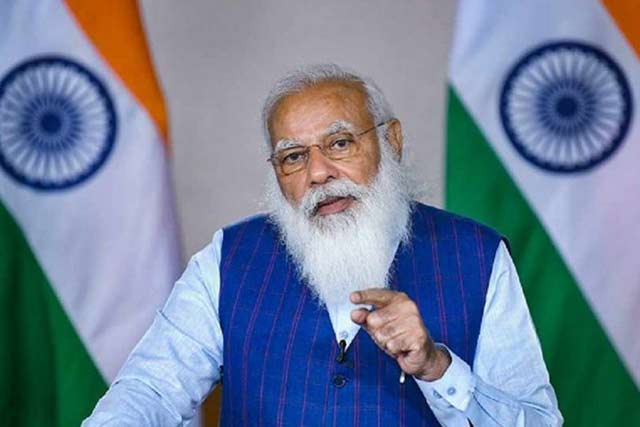According to a White House statement, Biden’s move to upgrade the country’s NDCs on Thursday will steer the world towards achieving the Paris agreement goal of limiting global warming to 1.5 degrees C
Prime Minister Narendra Modi on Thursday announced the launch of a joint climate and clean energy initiative with the United States to “mobilise investments, demonstrate clean technologies and enable green collaborations” in India that could also “create templates of sustainable development” for other developing countries.
PM Modi, speaking at the Leaders Summit on Climate convened by US President Joe Biden on Thursday, did not announce any changes or upgrades to commitments under the Paris Agreement but underlined that India was already doing its part and that the country’s per capita carbon emissions are 60% lower than the global average.
President Biden opened the summit with an ambitious pledge to cut the US’s greenhouse gases in half by the year 2030 and called upon other nations to “set higher climate ambitions” that will create jobs at home, advance innovative technologies and help countries vulnerable to the impact of climate change”.
“We in India are doing our part. Our ambitious renewable energy target of 450 GW by 2030 shows our commitment. Despite our development challenges, we have taken many bold steps on clean energy, energy efficiency, afforestation and biodiversity. We are among few countries whose NDCs (nationally determined contribution, under the Paris climate deal) are 2 degree C compatible,” PM Modi said in an address to over 40 other world leaders who participated in the two-day summit called by Biden.
“President Biden and I are launching the India-US Climate and Clean Energy Agenda 2030 partnership. We will help mobilise investment, demonstrate clean technologies and enable green collaborations,” Modi added.
No details were available yet on the India-US initiative, but on a visit to India last month, Biden’s special envoy on climate, John Kerry, said that “huge investments” will be forthcoming in India by the US and other countries in return for “some changes by India”.
Earlier this month, Union environment minister Prakash Javadekar underscored India’s prerogative to balance development goals with obligations on climate change, saying that the country will attempt to keep its climate commitments but will not act at the behest or under pressure from developed countries.
According to a White House statement, Biden’s move to upgrade the country’s NDCs on Thursday will steer the world towards achieving the Paris agreement goal of limiting global warming to 1.5 degrees Celsius.
The Climate Action Tracker, however, said that the US will need to do even more. Instead of the revised aim to to cut 50-52% in national emissions, it will need to shave off at least 57-63% emissions below 2005 levels by 2030 and provide support to other countries to meet the Paris climate goals.
Following the US’s announcement, independent experts said it is time for all countries, including India, to scale up action against climate crisis.
“President Biden’s upgraded NDC is a game changer. For too long the US has not put out an aggressive emissions reduction target. All countries could benchmark their lack of progress against the US… We think its time for all countries including India to upgrade action. As per the Climate Action Tracker, India’s NDC is 2 degree C compliant but not 1.5 degree C target compliant. We should ramp up action for our own good,” said Sunita Narain, director general, Centre for Science and Environment.
“The new US climate target is a step in the right direction: all major economies should be shifting towards cutting their emissions at least 50% by 2030,” tweeted Laurence Tubiana, CEO European Climate Foundation and one of the architects of the Paris agreement.
“The new NDC target that the US submitted today aims to reduce its GHG emissions by 50-52% below 2005 levels. Since the US’ emissions grew between 1990 and 2005, this new target roughly amounts to a 43-45% reduction below its 1990 emissions or its 2020 emissions. This is a step in the right direction, particularly when combined with its commitment to net-zero GHG emissions by 2050. Unlike the UK and EU, however, the US’s pledge is not yet enshrined in law. But it has the potential to spur technological innovation,” said Ulka Kelkar, director, climate programme, World Resources Institute.
In its Biennial Update Report to the United Nations Framework Convention on Climate Change (UNFCCC) submitted in February, India said it has progressively decoupled economic growth from greenhouse gas emissions and it was on track to meet its voluntary declaration to reduce emission intensity of GDP by 20-25% from 2005 levels by 2020. The report, however, also noted that India’s reliance on coal will continue to meet the country’s energy needs.
On Thursday, President Xi Jinping reiterated that China’s carbon emissions will peak before 2030 and the country will achieve carbon neutrality by 2060. Xi also emphasised on “the principle of common but differentiated responsibilities”, which argues for long-time polluters such as developed countries to do more to fight climate crisis.
Some experts agree. “Biden administration’s new climate target goes further than its previous commitment yet remains far from its ‘fair share’ of action. As the world’s biggest historical emitter, the US has a huge responsibility to the communities most affected by a crisis they did the least to cause,” said Harjeet Singh, ActionAid’s global lead on climate.
Japan Prime Minister Yoshihide Suga too announced that Japan aims to achieve carbon neutrality by 2050 and that it will cut its emissions by 46% over 2013 levels by 2030. The United Kingdom too led with a target of cutting emissions by 78% by 2035 compared to 1990 levels.
At the summit meant to signal the US’s return to the high chair after the Trump administration pulled out of the Paris agreement, Prime Minister Modi cited India as an example and called for more attention to “lifestyle changes” as a way to combat global warming. “India’s per capita carbon footprint is 60% lower than the global average. It is because our lifestyle is still rooted in sustainable traditional practices,” he said, adding that “back-to-basics” must be an important pillar of economic strategy for the post-Covid era.
The summit, termed by Biden as a milestone leading up to the United Nations Climate Change Conference 2021 in Glasgow this November, was also attended by UN secretary general Antonio Guterres, Germany’s Angela Merkel, France’s Emmanuel Macron and Russia’s Vladimir Putin.




































